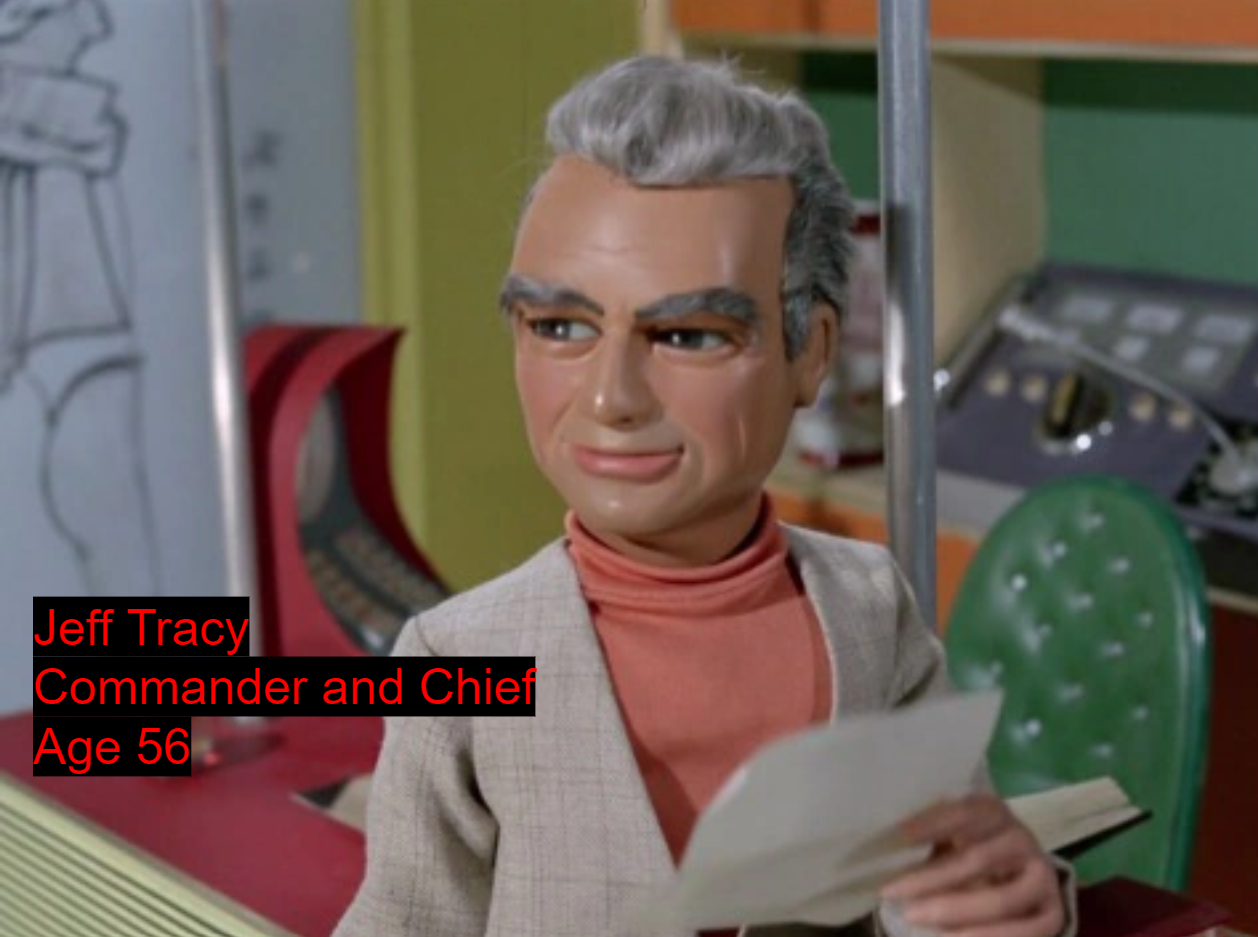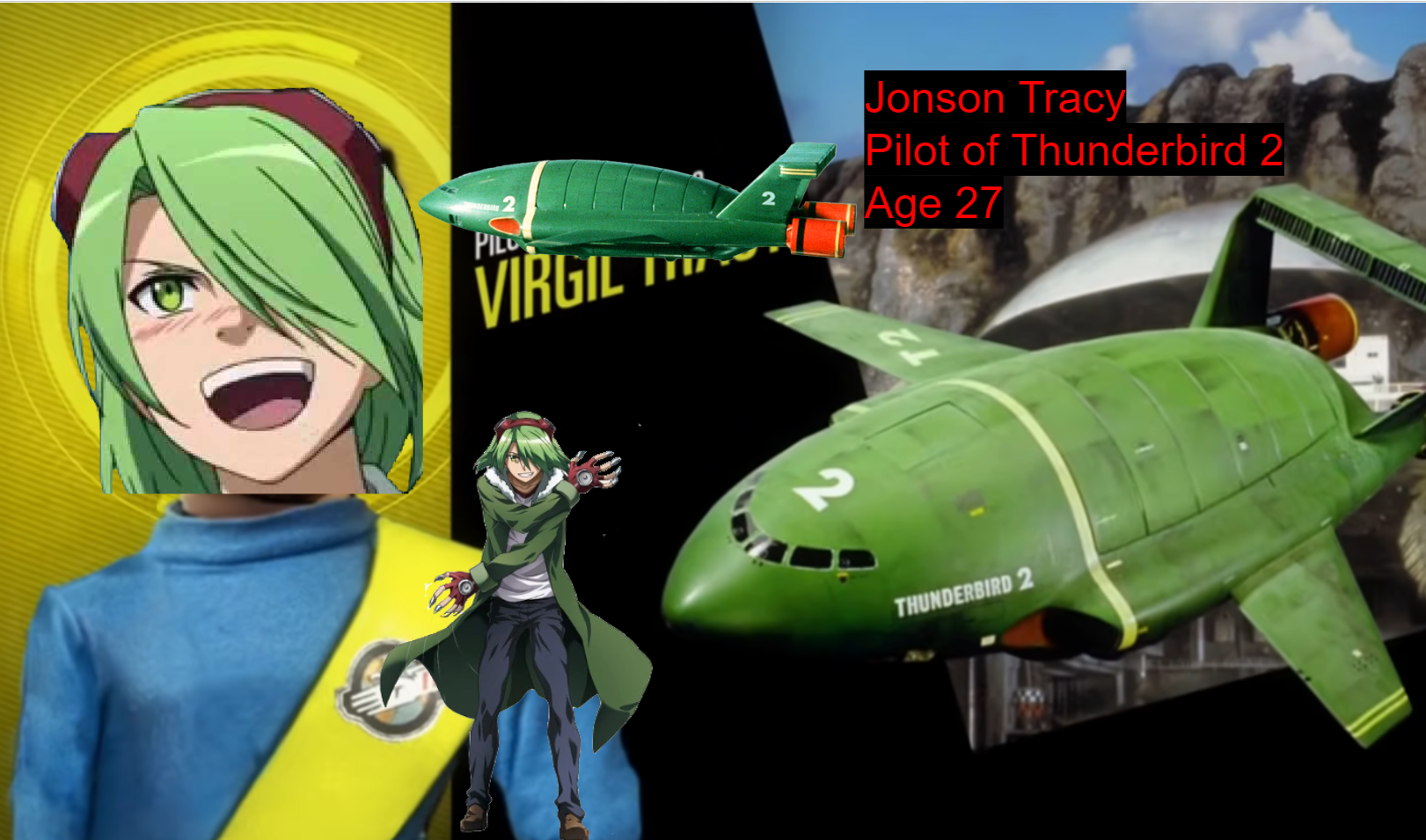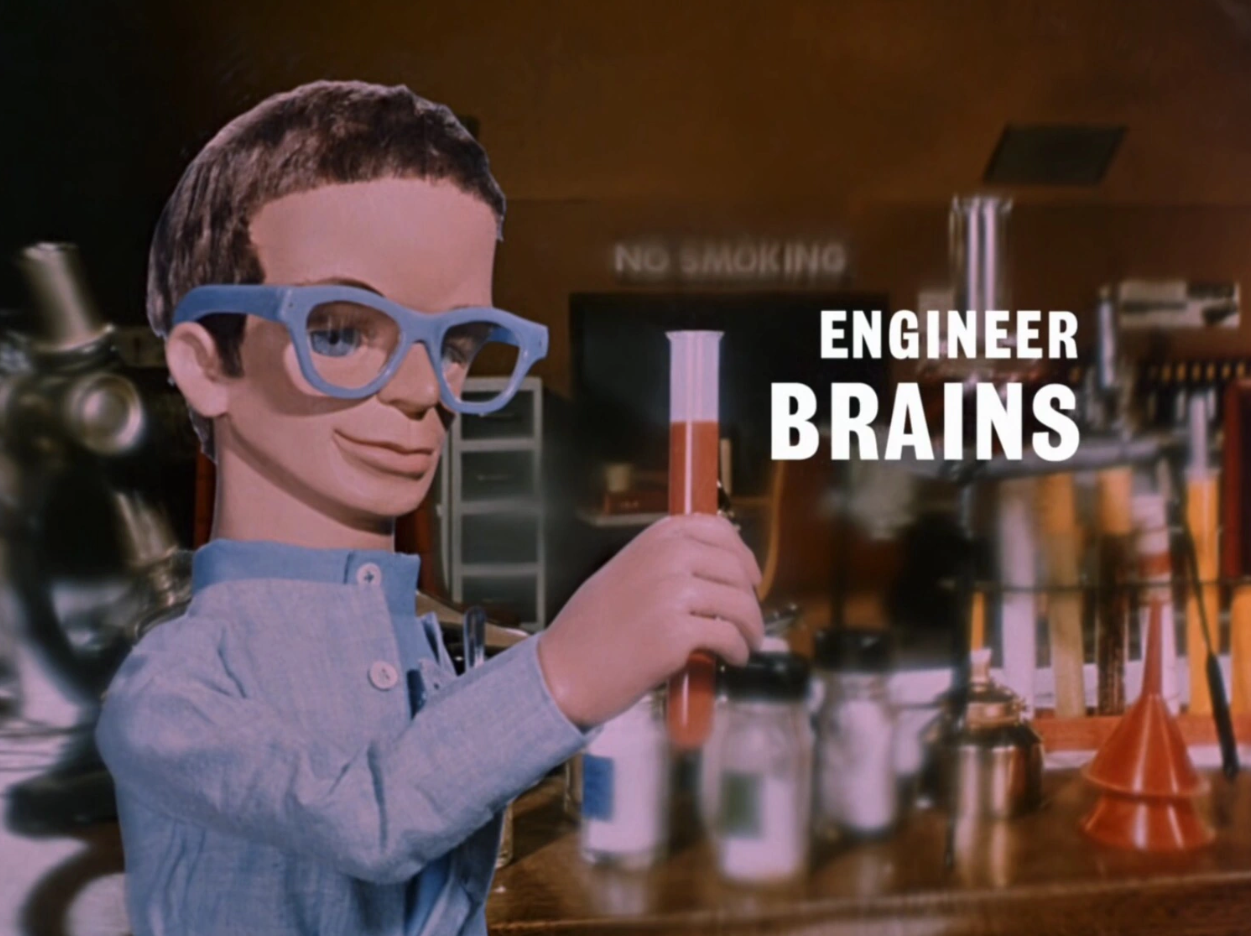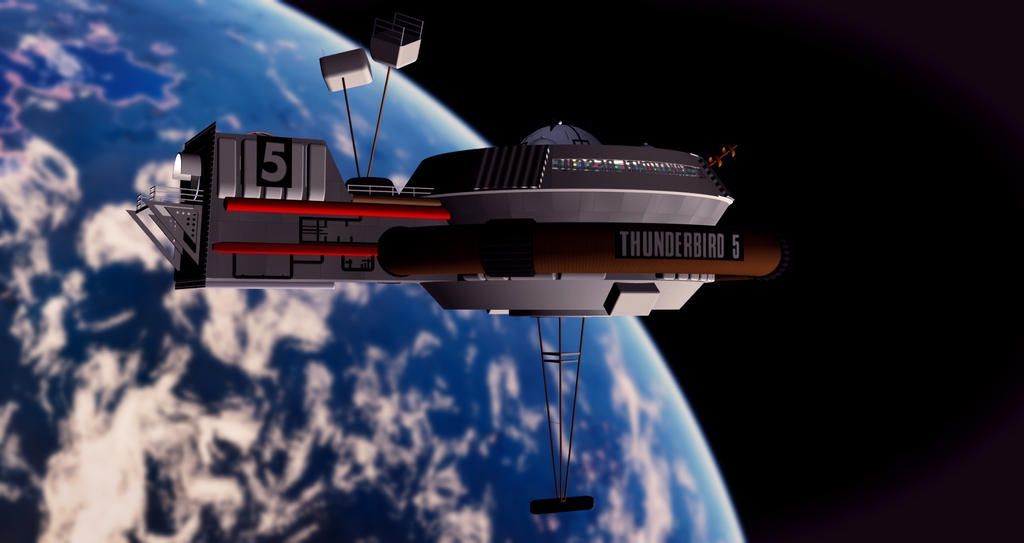
Thunderbird oc
my oc/ cannon team
Name Jeff tracy
age 56
gender male
Roll Commander and Chief
look

.
Name Kieron tracy
age 30
gender male
roll: Pilot of Thunderbird 1 and 2nd in command
look

.
Name Jonson Tracy
age 27
gender male
roll: Pilot of Thunderbird 2
look

.
Name sarah tracy
age 19
gender male
roll: Pilot of Thunderbird 3
look

.
Name apps tracy
age 22
gender male
roll: Pilot of Thunderbird 4
look

.
Name lily tracy
age 25
gender
roll: Pilot of Thunderbird 5
look

.
Name brains
age 25
gender male
roll: engineer and inventor
look

.
.
Tracy island
Island base
A few miles away from Vale but between Atlas, Biden from sight of anyone, there is an island similar to that of Martin Island, only it is named as Tracy Island. This place was the site of International Rescue headquarterers, and of the Thunderbirds.
Formed as a result of seismic shifts in the ocean bed during the late Triassic age, approximately 200 million years ago, the island and its near neighbor, Mateo, are peaks of a sub-aquatic ridge that stretches east across the main tectonic plate to its convergence with the plates. Now completely dormant, both islands were once volcanically active and are internally honeycombed with vast lava-formed chambers linked by a network of extinct vent channels. On the southern side of the island at sea level these form a network of cavernous grottoes, which are reputed to be the home of an elusive species of water mamba. The geological composition of the island's rock strata is also rich in valuable minerals, including sought-after deposits of the ultra-rare Cahelium X.
Following jeff purchase of the two islands in the early 2040's of the Thunderbirds base, work quickly commenced to create an idyllic, self-contained luxury retreat - indicating to the casual visitor Tracy Island was nothing more than a lavish millionaire's paradise, where the family could live a life of luxury oblivious to everyday reality. After construction of an airstrip leading from the northern edge of the island to the cliff-edge of a small plateau, well-placed to catch the dramatic sunsets, work started on a streamlined two-storey villa to Jeff personal design. Built on an outcrop of rock overlooking a palm-fringed apron, which offered the perfect location for a kidney-shaped pool, the villa quickly took shape. Additional accommodation was also planned and constructed to provide guest-quarters and leisure facilities. This consists of the Round House, a cantilevered doughnut-shaped residence built above a sunken circular oriental garden and accessed by a path running to the east of the main house; and the Cliff House, a jutting two-storey construction built into a cleft of rock situated above the landward end of the island's runway and topped with a domed concrete canopy. Internal lift and moving-walkway systems link Cliff House and Villa, with a small hangar entrance built into the base of the cliff. A further internal travel-way connects to a converted ocean-side cave, which acts as a boathouse for the family's various seagoing craft.
Within the Tracy Villa, there is a spacious lounge that forms the focus of the main building, with family bedrooms and a small laboratory workshop on the same floor - all fitted with the latest audio and visual systems, including micro-layer flatscreen TVs and total-surround audio players. There's also a family dining room, a breakfast nook and a modern kitchen fitted with the latest-model atomic cooker.
From the lower floor, access can be made to a complex of leisure facilities built into the island's labyrinth of caves. A gym, shooting range, billiard room, a small cinema, a music room and an indoor pool are just a few of the amenities that the Tracy family can enjoy during moments of relaxation. Just off the kitchen is a small tropical patio, with a door leading outside the villa.
The centre of family life, accessed by a smaller reception room leading off a central hallway, the main lounge is spacious and well-lit. Angled French windows along one wall open onto a full-length balcony, from the split-level floor space. Directly facing Ozpin's desk, to the left of the room's main entrance, visitors will see portraits of his five children in everyday casual attire.
In the far corner diagonally opposite the main entrance, are Kieron desk and work station. Behind the desk are shelves lined with books and personal mementos, surrounding a video monitor built into a compact electronic control unit and communication post. Originally mounted on twin supports (prior to recent redecoration), the desk could be raised to the ceiling when not in use - but as this proved rarely to be the case, it was replaced with a larger, conventionally supported version. However, this newer model lacked the flip-top feature of the original, which initially housed an electronic keypad and printer.

.
Thunderbird 1
The first of the ships is known as Thunderbird One. The craft has a sharp red nosecone, along with a cylindrical silver body, and a powerful blue engine. It has 4 variable-cycle gas turbine engines; 4 booster rockets; 1 variable-mode engine operating as a high-performance sustainer rocket for launch or boost as a variable-cycle gas turbine in flight. There is even the pitch and yaw jets; 20 forward and 25 rear. It also has a pair of small sweep wings on the sides of the craft, and the cross shaped bottom is positioned in the manner of a plus sign. It is 115ft tall, with a 80ft (35m when the wings are extended) wingspan, and a body diameter of 12ft. It has a definite underside and topside when flying horizontally; the underside has only one VTOL variable-mode jet engine operating as a rocket or variable-cycle gas turbine hover jet, while the topside has "THUNDERBIRD" written down it, completed by the "1" painted on both sides of the blue coloured section. The interior goes from the nosecone to the wings. The pilot's chair is located at the front, near the nosecone, where the windows are. There are no front facing windows, with the aerodynamic nosecone taking up the entire front.

.
Thunderbird 2
The second ship is Thunderbird Two, the workhorse of the fleet. This craft is a green colour scheme, with white writing of its name on either side of the cockpit, and the number '2' on the tail section, and the T2 on the wings. The craft has 2 variable-cycle gas turbine engines operating as turbofans at low speed and supersonic combustion ram jets at high speed, with 12 variable-cycle turbo-ram cruise / trim jets in the tailplane, 4 VTOL turbofan jets in the main body, and 4 VTOL chemical rockets in the landing legs. The ship is 60ft tall (110ft with the pod lowered), while being 250ft long, with a 180ft wingspan. It has an atomic fusion reactor for its power source. Thunderbird 2 is comprised of two parts: a framed superstructure and a pod. Thunderbird 2's frame incorporates the cockpit, wings, and fuel tank near the vehicle's front, and at the rear the engines and the tailplane, which serves to aid lift and stability. Two stilts are located each at the front and back of the craft to hydraulically lift the craft upward, allowing for the clearing of the pod. Its middle is hollow, to fully accommodate one of the six pods that is required for the mission. Each pod is equipped with undercarriage for a smooth landing for the ship, and contains a huge capacity for storing the rescue vehicle that is needed. The craft is, however, completely capable of vertical takeoff and landing without the pod, but has less integrity this way.

.
Thunderbird 3
The third vessel is the rocket ship, Thunderbird Three. This rocket is 287ft tall, with a body diameter of 70ft, with a wingspan of 70ft, the nacelle span of 80ft, while having a maximum acceleration of 10Gs (over 30,000mph). The drive system is an Ion-drive particle accelerator, with a hybrid electromagnetic/rocket motor. The vessel is in bright red with a white 'THUNDERBIRD' leading back to the dark grey fan-like structure in the middle of the vessel, with three arm-like protrusions on either side of the craft's body, which link up with the three-engine rounded base of the rocket, the number 3 in white on the base. The cockpit is located in the upper-middle of the rocket's body and it has 4 seats. This rocket has Engines: 3 chemical rocket boosters used for launch, landing, emergency boost, and orbit change, with 3 ion-drive particle accelerators used in deep space, along with pitch and yaw rockets. There are 12 boosters in middle ring for course corrections, 20 in the nose and 24 at the rear for attitude adjustments. The rocket has an atomic fusion reactor, an emergency acceleration of 10Gs, with a launch thrust of 4.5 million pounds, a max sustained acceleration of 6Gs, and standard acceleration of G1s.

.
Thunderbird 4
Finally, there is the small yellow submersible known as Thunderbird Four. This small submarine seems to be like a small pocket rocket with a small tailfin on the back of the craft with the rear engines on either side of the craft, and on the front of the sub is a light bar. The craft is 30ft long, with an 11ft width, and weighing 16 tonnes. Is has 4 vertical-thrust hover jets, and 2 x 25 liquid fuel mini-rockets. Is has 6 electrically driven reversible axial-flow turbine impellers for forward and reverse drive. The main turbo drive is 2 axial-flow turbines, providing forward thrust only. It's power source are twin atomic fusion reactors. It's surface cruising speed is 40 knots, with an underwater speed of 160 knots, an emergency launch speed of 30mph. The maximum speed underwater is 160 knots, with a max operating depth of 30,000ft below sea level.

.
Thunderbird 5
Thunderbird 5 - International Rescue's geo-stationary orbital satellite - monitors radio frequencies, 24/7, for distress signals.
Usually manned by primary space monitor Dark, we're informed in-series that he trades-off with Sarah or Lily - and sometimes even me - on one-month shifts aboard the station. Brains is a frequent visitor, to assure TB5 keeps in perfect working order; and even Virgil and Gordon have visited on occasion!
Bristling with antennae and a myriad of sophisticated listening devices, TB5 is a world all its own - unique, even amongst the company of its sister Thunderbirds. Its mission is of paramount importance to the very existence of International Rescue...
Step into its spacious control room - and be greeted by a spectacular vista of the Earth, through a long observation window of thick shatterproof glass. Elsewhere, along one entire wall, countless radios (covering most frequencies) and speakers enable whoever's on monitor duty to listen to incoming signals in all as many languages.
This sensitive equipment (capable of transmitting and receiving both audio and video) detects, amplifies and (as necessary) translates appeals for help - assistance IR, alone, is capable of providing - which are then relayed to IR headquarters on Tracy Island for action; and, once again, Thunderbirds are GO!
Although well-shielded and otherwise protected, TB5's main control room is further backed-up by a specially-built duplicate control facility should an emergency situation arise. All monitoring functions are automatically transferred; computer systems are independently-powered via the adjacent solar energy panels, and all data is duplicated from the primary systems, to assure that TB5 remains in continuous service.
Thunderbird 3 provides transport to and from Thunderbird 5 - docking with the space station via its custom-designed docking collar and airlock - as well as caches of fresh supplies and transfers of monitor personnel.
Just off the control room, are sleeping quarters where the crew can rest when not on-duty. Since rescue calls detected by the station's computers are broadcast throughout TB5, John can easily access these communications wherever he is on the station, at any given moment...
Diameter (including meteor deflector): 296 feet
Gravity: Previn coil artificial gravity
generator: Earth standard (with various options)
Height (including antenna): 272 feet
Length: 400 feet
Orbit: geo-stationary 22,400 miles above the Pacific Ocean
Power: atomic batteries
Reception range: 100 million miles
Weight (standard Earth gravity): 976 tons

.
.
Pod Vehicles
the Excavator
The DOMO (Demolition and Object Moving Operator)
The Mole
The Firefly
The Recovery Vehicles
The Monobrake
the Elevator Cars
the Laser Cutter Vehicle
The Transmitter Truck
The Booster Mortar
The Jet-Air Transporter
The Fire Truck
The Fire Tender
The Neutralizer Tractor
and many, many more

Bạn đang đọc truyện trên: Truyen247.Pro